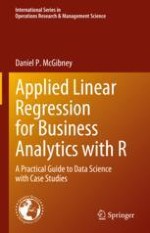Applied Linear Regression for Business Analytics with R introduces regression analysis to business students using the R programming language with a focus on illustrating and solving real-time, topical problems. Specifically, this book presents modern and relevant case studies from the business world, along with clear and concise explanations of the theory, intuition, hands-on examples, and the coding required to employ regression modeling. Each chapter includes the mathematical formulation and details of regression analysis and provides in-depth practical analysis using the R programming language.
